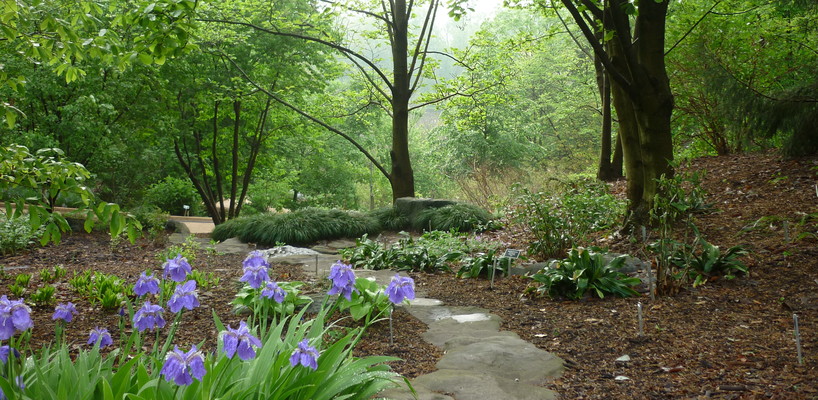
Asian Collections
Sloping steeply from the heights of Hickey Hill to the flood plain of the Anacostia River, the Asian Collections provide some of the Arboretum’s most dramatic views and unique plants, many of them wild-collected. There is something blooming here in every month of the year.
Each part of the Asian Collections offers something different to experience. The Camellia Collection begins flowering mid-autumn and continues, weather permitting, through winter into spring. Many of these plants are the product of a breeding program utilizing cold hardy camellias, and include a series of popular hybrids that were bred here at the Arboretum after severely cold winters in the 1970s devastated the original collection. Witch-hazels (Hamamelis species) and flowering apricots (Prunus mume) decorate the open vistas on the north side of Hickey Hill in late winter, while the Japanese Woodland, a serenely calming space, invites you to explore the details of bark, leaves, texture, and flowers of woodland plants. Asian Valley offers dramatic views that capture beautiful plants like the spring-blooming bog primroses (Primula japonica) and the rare dove tree (Davidia involucrata). A Chinese pagoda-style gazebo overlooks both Asian Valley to the left and China Valley to the right. A more open area, China Valley’s winding path passes through a paradise of plants. Meanwhile, the Korean Hillside, located near the top of Hickey Hill, is set against a backdrop of white pines and is punctuated by a weeping Katsura tree (Cercidiphyllum japonicum Pendulum Group), which is wonderfully fragrant in the fall (it smells like cotton candy). The incredible variety of Asian plants ensures that there is always something new to discover here, no matter how often you visit.
Asian plants are fascinating not only for their diversity, but also because they often bear a striking resemblance to our native eastern United States flora. Millions of years ago, a shared forest flora stretched across most of the Northern Hemisphere. Over time, a cooling and drying of the climate at both global and regional scales caused that shared flora to shrink dramatically. While species native to the once-widespread forest zone went extinct in many regions, the climate in parts of eastern Asia and eastern North America remained continuously warm and humid enough to sustain them, providing safe havens for the ancestors of many plants we know today. The resemblance we see between the floras of eastern Asia and eastern North America is not just a coincidence: they are really just estranged cousins, refugees of natural climate change now separated by vast distances, but sharing the same ancient roots.
TIPS FOR VISITORS
The Asian Collections cloaks 13 acres of slopes from the top of Hickey Hill to the Anacostia River. None of the trails in this collection are handicapped-accessible, and good walking shoes are a must. Drive to the collection, park in the small parking area, and take a brochure. The map will be helpful in navigating the trails. The stone steps lead into the Japanese Woodland, wend their way through the top of Asian Valley, and end up in China Valley.
Most visitors spend a minimum of one hour in the Asian Collections. Be sure to budget some time for resting and admiring the view. Other collections are easily accessed from this area, and many visitors continue their visit in the nearby Gotelli Conifer Collection, the Dogwood Collection, and the Holly and Magnolia Collections.